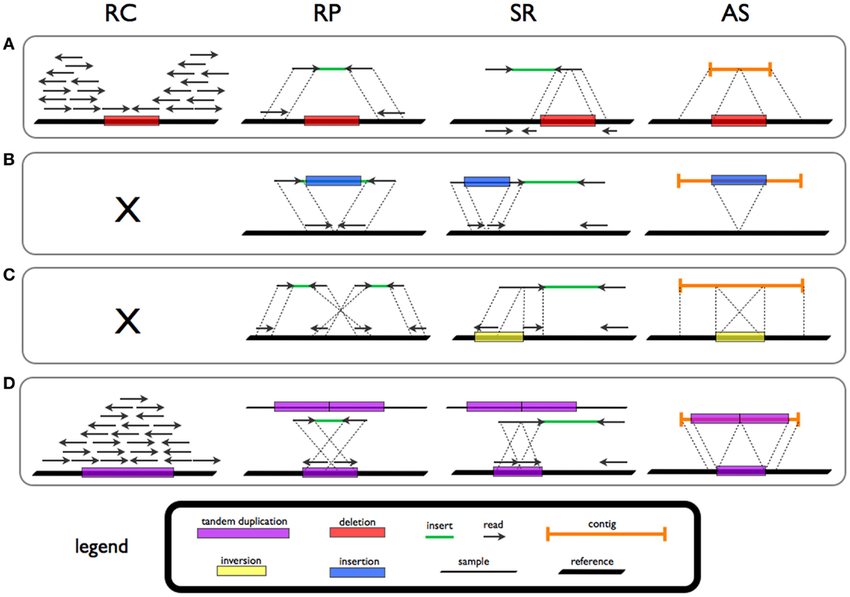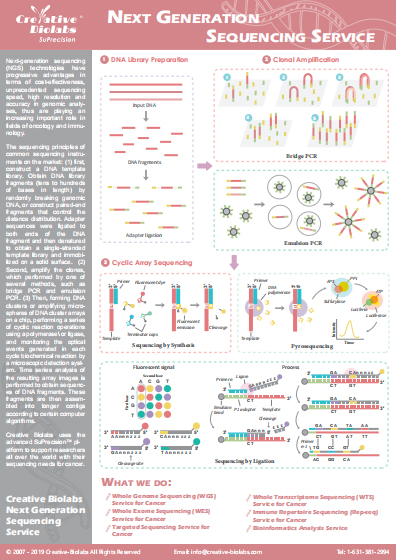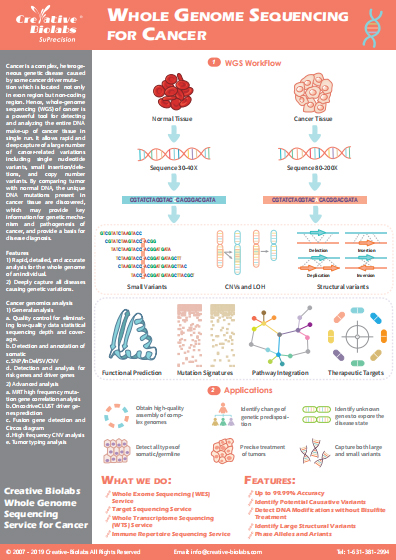
Whole Exome Sequencing (WES) based Structural Variant Detection Service
Equipped with world-leading technology platforms and professional scientific staff in next-generation sequencing (NGS), Creative Biolabs has established an advanced SuPrecision™ platform for NGS service. We have offered many whole exome sequencing (WES) services to our global customers to help their related project development. Our scientists have developed a novel toolkit for structural variants (SVs) detection. We can provide the most accurate results with the lowest false positive calls to meet your related project development goal in a time-saving manner.
The Properties of SVs
SVs are genomic rearrangements, more than 50 bp accounting for around 1.2% of the variation among human genomes while single nucleotide polymorphisms (SNPs) represent 0.1%. The average SV size detected by the 1000 Genomes Project is 8 kbp, whereas a study based on tiling CGH array reports a four times larger value. SVs comprise balanced as well as unbalanced events, namely, variants altering the total number of base pairs in a genome. Thus, SVs include deletions, insertions, inversions, mobile-element transpositions, translocations, tandem repeats, and copy number variants. They impact on phenotypic diversity and play a role in various diseases including neurological/neurocognitive disorders and cancer development and progression.
General Strategies for the Detection of SVs
Four strategies for the detection of SV signatures that are diagnostic of different rearrangements have been reported. (1) read-pair (RP) methods are based on the evaluation of the span and orientation of paired-end reads. (2) read-count (RC) approaches assume a random distribution in mapping depth and investigate the divergence from this distribution to highlight duplications and deletions. (3) split-read (SR) methods allow for the detection of SVs with single base-pair resolution. (4) De novo assembly (AS) refers to merging and ordering short fragments to reassemble the original sequence from which the short fragments were sampled. Theoretically, all forms of structural variation could be investigated by means of AS methods. Next-generation sequencing technologies (NGS) have been revolutionizing genome research as well as the study of SVs on the whole, replacing microarrays as the leading platform for the investigation of genomic rearrangement. None of the aforementioned approaches is capable of capturing the full spectrum of SV events with high sensitivity and specificity. The complete range of structural DNA variation cannot be investigated with a single tool.
 Fig.1 Signatures and patterns of SVs for deletion (A), novel sequence insertion (B), inversion (C), and tandem duplication (D) in read count (RC), read-pair (RP), split-read (SR), and de novo assembly (AS) methods (Tattini et al. 2015).
Fig.1 Signatures and patterns of SVs for deletion (A), novel sequence insertion (B), inversion (C), and tandem duplication (D) in read count (RC), read-pair (RP), split-read (SR), and de novo assembly (AS) methods (Tattini et al. 2015).
SVs Detection Service at Creative Biolabs
Creative Biolabs has developed a novel toolkit by combining RC, RP, SR and AS to exploit the WES data for SVs detection. Our toolkit is particularly well-suited for the investigation of copy number variants of SV, and breakpoint can be predicted down to single-base resolution. Based on this advanced toolkit, not only large events can be detected, breakpoints can also be identified accurately with low false positive calls.
Key Advantages of SV Detection Service at Creative Biolabs Include but Are Not Limited to:
- A novel toolkit for SV detection
- Low false positive calls
- High accuracy, down to single-base resolution
- Extensive experience
- Fast turnover time
Creative Biolabs is fully competent and dedicated to serving as your one-stop-solution for SV detection. We can offer high accurate (down to single-base resolution) identification of breakpoints with low false positive calls. Creative Biolabs is pleased to share our cutting-edge technology and extensive expertise in SV detection with the best service at the most competitive cost.
Please contact us for more information and a detailed quote.
Reference
- Tattini, Lorenzo, Romina D'Aurizio, and Alberto Magi. "Detection of genomic structural variants from next-generation sequencing data." Frontiers in bioengineering and biotechnology 3 (2015): 92. Distributed under open access license CC BY 4.0, without modification.
Resources
Infographics
Podcast
- TMB Analysis for Checkpoint Immunotherapy Response
- WES based Variant Analysis
- WES based CNV Detection
- WES based Tumor-Specific Neoantigen Discovery
- WES based Biomarker Discovery
- Personal Tumor-Specific Neoantigen Vaccine Development
- MRD Monitoring
- Microsatellite Instability Analysis
- Immune Repertoire Germline Gene & Allele Identification
- One-Stop Cancer 3D Modeling
- Circle-Seq based eccDNA Identification
- RNA-Seq based Tumor Microenvironment Analysis




